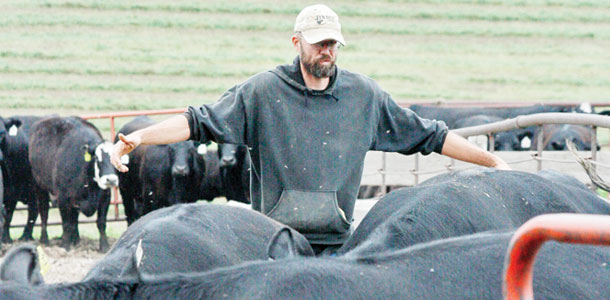Preventing injury saves time, money and stress.
“Many times agricultural operations don’t have a lot of extra employees, so staying healthy is important to get all the chores done and to maintain the sustainability of the operation,” says Rachel Endecott, Ph.D., extension beef/cattle specialist at Montana State University.
The leading cause of accidents on any farm or ranch is due to equipment. “In agriculture, tractors and powered machinery are the most common mechanism of traumatic injury.
In ranching, these are used to move feed and other large loads,” states Dr. Fred Gerr, director of the Great Plains Center for Agricultural Health.
According to the 2011 farm and ranch safety survey conducted by USDA’s National Agricultural Statistics Service (NASS) for the National Institute for Occupational Safety and Health (NIOSH), “Tractors are the leading cause of occupational fatalities in agriculture.
Of the estimated 4.4 million tractors in operation on farms and ranches in 2011, 2,563,000 or 59 percent were equipped with a roll-over protective structure (ROPS), a proven engineering control in the prevention of tractor overturn deaths.
More than 3,000 operations were estimated to have at least one tractor overturn in the previous 12 months; 1,600, or 53 percent, of these overturned tractors were equipped with ROPS.”
Training and prevention
Preventing injury on equipment starts with good training. “Regarding machinery, all workers should be trained on safe operations of machinery, and owners must ensure that all safety devices, especially ROPS on tractors, power takeoff shaft guards, pinch point guards, entanglement guards and shields, are installed and properly maintained,” Gerr explains.
There are other sources of injury ranchers need to be aware of as well. “In addition, falls, repeated muscular exertions such as lifting and handling power tools are also important sources of injury.

Animals are an important source of injuries due to workers being struck by animals, stepped on by animals and experiencing needle-stick injuries from animal medications,” says Gerr.
To prevent injury with animals, Gerr suggests ranchers handle them carefully. “Safe animal-handling techniques are an important practice for preventing injury resulting from working with animals.
This is a specialized area of safety behavior that includes knowledge of animal behavioral responses to stress and construction of corrals and animal facilities that limit the opportunity for animals to harm humans,” he states.
Geared to ATV safety
As more ranches move from using horses on the ranch to ATVs, the number of ATV injuries is also increasing. “ATVs, another source for injury, are common on agricultural operations.
In 2011, there were an estimated 1,580,000 ATVs in use on farms and ranches – 1,385,000, or 88 percent, of which were used for work. Of the ATVs used for work, 107,000, or 8 percent, were equipped with a power take-off (PTO) drive,” according to the NASS study.
It continued, “The most common work tasks for which an ATV was used were general farm transportation, moving materials, spraying and moving livestock.
In 2011, there were an estimated 836,000 ATVs used for general farm transportation, 541,000 were used to move materials, 332,000 were used in spraying, and 309,000 were used for moving livestock. Over 119,000 operations had youth less than 16 years old who operated ATVs.”
Many ranchers try to use an ATV the same way they would use a horse. This can lead to roll-overs, and many ATVs are not equipped with rollover bars, resulting in serious injury for the operator.
“If a rancher is on uneven territory or it’s steep, they need to invest in a rollover bar. Trying to cowboy on one without this bar can result in accidents,” says Tony Hass, owner of Eagle Rock Ranch near Trinidad, Colorado.
Hass usually runs around 450 pairs and has suffered many ranching accidents during his lifetime. He has ranched his entire life and believes taking a common-sense approach to safety is vitally important.
“Common sense prevails. You need to stay cool and don’t take shortcuts. That’s when accidents happen,” says Hass. “You need to be aware of your surroundings and let people know where you are going when you leave.”
Cool, calm and collected
Staying cool and not allowing a temper to flare is very important, especially when working with cattle. Taking shortcuts that bypass safety measures to save time can result in serious injury, setting back a rancher days or even months.
“Don’t get in a hurry. When you get in a hurry, you do stupid things and can get hurt,” states Hass.
If an injury does occur, first and foremost, emergency personnel should be contacted immediately if the injury is serious or life-threatening.
According to Dominic (Junie) Verquer, emergency preparedness and response coordinator for Las Animas County in Colorado, “The first step is to control the bleeding. Usually the EMTs can be there pretty quickly. The next step is to keep them calm and keep them warm. You don’t want them to go into shock.”
Verquer oversees the third-largest county in the country and also sees rattlesnake bites with ranchers. “In the event of a rattlesnake bite, it’s important to stay calm and keep the injury below the heart. You need to try to not get your adrenaline pumping,” he explains.
If it’s not an emergency, seeing a doctor is still important. “If you are hurt and it’s not an emergency, don’t hesitate to go get checked out. A lot of time ranchers have the tough guy, tough girl mentality,” explains Endecott.
She adds, “We need to go to the doctor sooner. Going and getting checked out to make sure you are OK is a great idea.”
Hass agrees. “These injuries don’t seem like much to cowboys, and they won’t stay down. They want to keep working. But when they get to be 50, it all catches up with them.
Ranchers who have had multiple injuries, that really affects them when they are older through things like arthritis or herniated discs. When you are working in the industry, you don’t realize all the different ways you may have been hurt,” he states.
After an injury has occurred, a rancher needs to take a look at what happened. “Taking a good critical evaluation of what happened and what we could have done to prevent it is important.
We also need to look if there needs to be a modification of the working facility to lessen the chance of that accident happening again,” says Endecott.
Prevention is always the best measure to take when it comes to injuries in ranching. “Agriculture is among the most dangerous of all occupations in the U.S., and prevention is effective at minimizing harm that causes pain, impairment, loss of life quality and loss of revenue. We do advocate prevention in order to minimize risk of serious injuries,” says Gerr.
Preparing for the worst
Part of prevention includes keeping facilities fixed and clean, equipment in working order and being prepared before a rancher leaves the house.
“It’s wise to have an avalanche-type kit. In general, most people are of the mind that they aren’t that far away. It may be good to have a small kit for your saddlebags, but there probably aren’t a lot of ranchers who do that right now,” states Endecott.
That saddlebag kit should include items such as water, food, a rain slicker, a flashlight and a small emergency kit. “When you are packing to leave, slow down and make sure you have what you need.
If you are going to be gone for a few days, or even a few hours, it’s important to carry these items. I keep it tied on behind my saddle and dress in layers,” explains Hass.
He also suggests applying sunscreen every day. “Sunscreen is a must. People will get benign versions of issues on their skin and that can turn to skin cancer,” he states.
Verquer also suggests wearing the appropriate clothing. “Long-sleeved shirts and a wide-brimmed hat are also really important,” he says.
Heat stroke is also a real issue that ranchers face, and staying hydrated is of utmost importance. “You need to stay hydrated. Heat strokes are not good. If you don’t drink enough water, heat strokes can be really common among ranchers,” says Hass.
Carrying a locator beacon or a cell phone with GPS is important, especially if a rancher is in a remote area. “When I was out in the blizzard of ’06 gathering cattle, I got lost for a little while driving cattle, and a beacon would have been helpful.
You don’t think of that, and you can panic. I also had a horse fall on me 8 miles from the house and I broke my leg, and rode back with a broken leg. It would have been very helpful then to have a locator of some sort. It really scared my wife,” says Hass.
Being prepared, knowing what to do when an accident occurs and making improvements to prevent future injury is important on the ranch. “Be safe in whatever you do. Stay active, and be precautious. Every day is a challenge,” states Verquer. ![]()
Robyn Scherer is a freelance writer based in Colorado.
PHOTOS
PHOTO 1: Careful handling of livestock includes knowing your corrals and equipment sufficiently for safe operation.
PHOTO 2: Know your surroundings and try to avoid hurrying cattle when moving them around. Photos by David Cooper.







